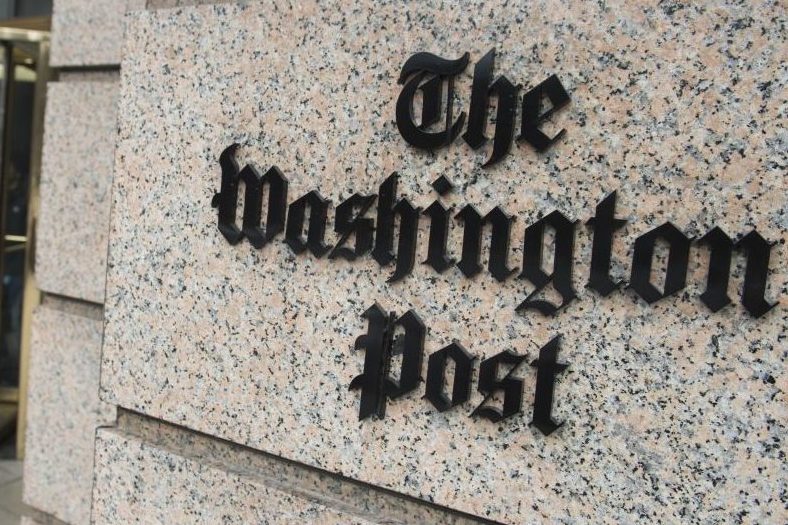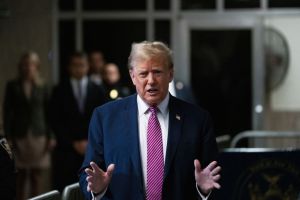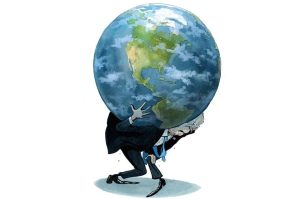The Washington Post issued a mammoth correction this week on a story about Donald Trump’s search for election fraud. The paper had admitted that they misquoted the former president twice. WaPo’s botched story is a cautionary tale of what happens when political biases cloud reportage and a reminder of why public trust in the media is so low.
The original story, which was reported in January and written by Amy Gardner, broke the news that Trump had a December phone call with Georgia’s top election investigator about the 2020 presidential election results. The scoop was sourced to an ‘individual briefed on the call’, who claimed Trump urged the official to ‘find the fraud’ and promised she’d be a ‘national hero’ if she did so. Both of these quotes were fabrications, according to a recording of the call published by the Wall Street Journal.
‘Democracy dies in darkness’, is the Post‘s pompous slogan. Well, the media dies in lies.
‘Two months after publication of this story, the Georgia secretary of state released an audio recording of President Donald Trump’s December phone call with the state’s top elections investigator,’ WaPo wrote in its mea culpa. ‘The recording revealed that the Post misquoted Trump’s comments on the call, based on information provided by a source’
The first, most obvious problem with the story is that WaPo sourced it to someone who wasn’t even on the call. This means the source would’ve had to get direct quotes, then remember those quotes exactly enough to relay them to the WaPo reporter. That seems unlikely. It was at this point that the reporter should have chosen to paraphrase the conversation or, better yet, get a second source — preferably one who was actually on the call — to confirm.
The source, who was identified in a later story as Jordan Fuchs, the deputy secretary of state, admitted she should have summarized the call to Gardner rather than give alleged quotes.
‘I believe the story accurately reflected the investigator’s interpretation of the call. The only mistake here was in the direct quotes, and they should have been more of a summary,’ Fuchs told WaPo.
Still, Fuchs insisted that the absence of the ‘find the fraud’ and ‘national hero’ quotes do not change the tenor of the call.
‘I think it’s pretty absurd for anybody to suggest that the president wasn’t urging the investigator to “find the fraud,”’ Fuchs said. ‘These are quotes that [Watson] told me at the time.’
It’s not surprising that Gardner did not attack the story with an appropriate amount of skepticism. She had already published the full audio of Trump’s call with Georgia secretary of state Brad Raffensperger, during which the then-president asked him to ‘find’ 11,000 votes and insisted they won the state by ‘hundreds of thousands of votes’. Fuchs’s description of Trump’s call with the election investigator likely rang true (as Fire and Fury author Michael Wolff infamously told MSNBC when questioned about inaccuracies in his book about the former president). Plus, it was another juicy anti-Trump scoop she could put under her belt.
Gardner was indeed so confident in this secondhand source that the bulk of her reporting was not even spent confirming the details of the call, but in alleging Trump had done something illegal. The reader was thus conditioned to believe that the reporting of the contents of the call was airtight enough to warrant an investigation into possible criminality.
‘The president’s attempts to intervene in an ongoing investigation could amount to obstruction of justice or other criminal violations, legal experts said, though they cautioned a case could be difficult to prove,’ Gardner wrote in the third paragraph of the story. The headline similarly warned that ‘experts say’ Trump could be guilty of ‘obstruction’.
One of the experts, however, identified the chief problem with Gardner’s story: there was no audio.
‘Robert James, a former prosecutor in DeKalb County, Georgia, said that proving obstruction would hinge on what Trump said and the tone he used, as well as whether the president’s intentions were clear. Without the audio of the call, it would be more difficult to prove wrongdoing, he said,’ Gardner reported.
That was at least the second point at which Gardner should have stopped and realized that her reportage was built on a house of flimsy cards.
Instead, WaPo went ahead and published the story. This single-sourced ‘bombshell’ was then ‘confirmed’ by numerous other mainstream outlets, including CNN, the Associated Press and the New York Times. The AP cited ‘a source’, CNN relied on ‘a source with knowledge of the call’, and the NYT used ‘a state election official’ who ‘was not authorized to speak about the matter’.
All of these outlets also used a single source to ‘confirm’ WaPo‘s reporting. None of them indicated that they had a source who had actually been on the call. Could Fuchs have been the same source for multiple outlets? History tells us it’s not beyond the realm of possibility. In 2018, CNN ran a story claiming that former Trump lawyer Michael Cohen was prepared to tell Special Counsel Robert Mueller that Trump had advanced knowledge of a Trump Tower meeting between campaign officials and a Russian operative. Lanny Davis later admitted to being a source for the later debunked CNN story, as well as independently confirming it to the New York Post and the Washington Post. This type of circular sourcing was used during the FBI’s investigation into the Steele dossier as well — a Yahoo! News reporter was able to publish the unverified allegations from the dossier by pegging the story to the fact the FBI was investigating the document. The FBI later used that story in applications for surveillance warrants against Carter Page, suggesting that the dossier’s presence in the news media lended it some credibility.
Contrary to what Fuchs claimed, Trump’s phone call with the Georgia investigator is not nearly as damning without the ‘find the fraud’ quote. In the recording, Trump merely asserts that there was something amiss in the Fulton County votes. The call no longer supports the suggestion that Trump wanted to fabricate fraud in order to overturn the election. Although Trump’s call with Raffensperger may still be interpreted that way, in this one he sounds quite sincere in believing that there was fraud and that it is Georgia’s job to investigate it thoroughly.
The fact that WaPo bungled this story so thoroughly is disturbing by itself, but even worse is how it was then used by Democrats to support an impeachment charge. The House impeachment managers cited the WaPo report, including the fake quote, in its trial brief against the President. Rep. Madeleine Dean of Pennsylvania later cited it in her oral argument during the actual impeachment trial. Trump was ultimately acquitted by the Senate, despite Democrats using fabricated evidence against him.
Trump weighed in on the debacle in a statement released Monday from his Save America PAC:
‘A strong democracy requires a fair and honest press. This latest media travesty underscores that legacy media outlets should be regarded as political entities — not journalistic enterprises. In any event, I thank the Washington Post for the correction.’
WaPo may point to its correction as proof that the paper tries to hold itself accountable, but an honest outlet would have never run the story in the first place. Plus, these corrections never get nearly the same amount of coverage as the initial, false article. The result is an even further divided populace: one side that is angry about a story that is untrue, and the other that is angry at repeatedly being lied to by the media. The former president is right: this is not good for democracy.


















